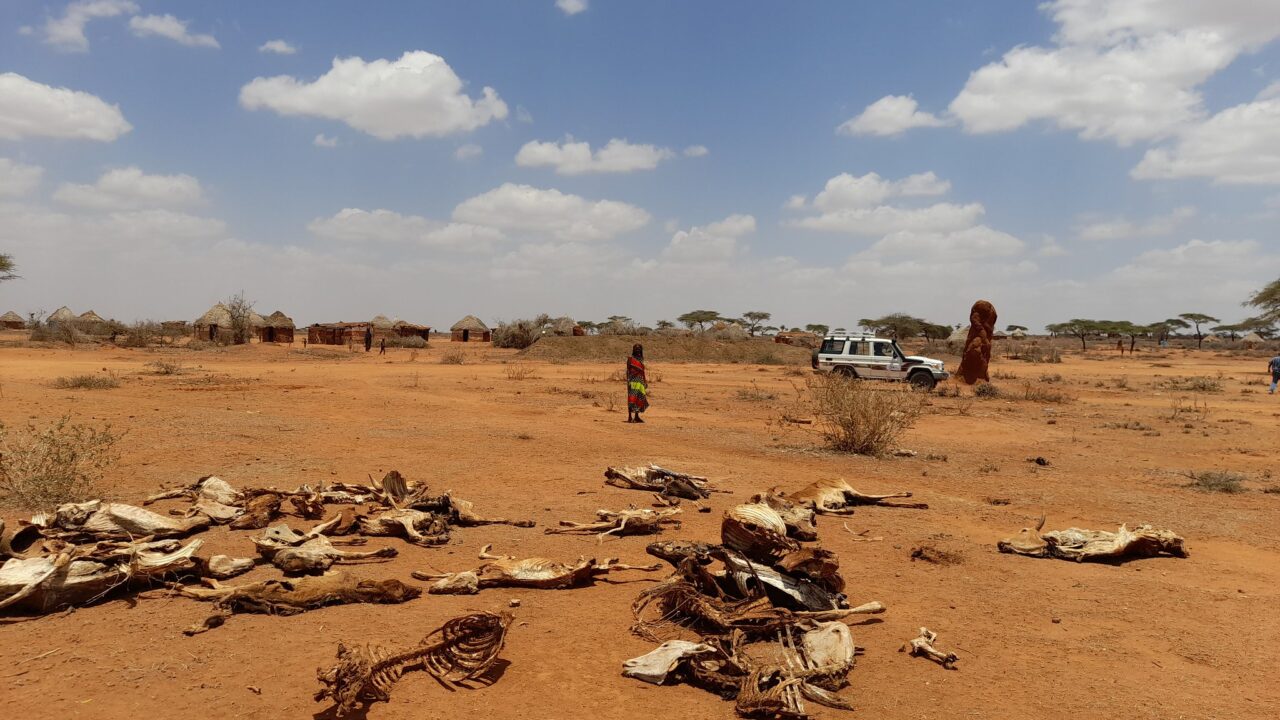Climate Change Causes Deadly Draught in Africa
Severely dry conditions have led to acute malnutrition in children and the death of livestock. Draught in Ethiopia by EU Civil Protection and Humanitarian Aid via Flickr / CC BY-SA 3.0
Draught in Ethiopia by EU Civil Protection and Humanitarian Aid via Flickr / CC BY-SA 3.0
For more than two years, countries including Kenya, Ethiopia, and Somalia have faced their driest conditions in four decades.
The drought has caused crops to fail and killed livestock, sparking crisis in a region already suffering from poverty and poor infrastructure. In 2022, 942,000 children aged between six months and five years suffered from acute malnutrition in Kenya alone. Across Kenya, Ethiopia and Somalia, 3.3 million people have had to leave their homes.
The new analysis finds that droughts like the one recorded in the Horn of Africa over the past two years have been made at least 100 times more likely by climate change.
This is largely due to increases in temperature, which are causing plants to release their moisture much faster—leaving soils dry, the scientists say.
The findings are the latest in “attribution science”, which has linked human-caused climate change to deadly floods in west Africa, damaging cyclones in southern Africa and record heat in the US, among hundreds of other extreme weather events.
Previous Carbon Brief analysis found that extreme weather events killed at least 4,000 people and affected at least 19 million people across Africa in 2022.
The dry conditions have fuelled a humanitarian crisis in a region that already suffers the impacts of poverty and poor infrastructure.
For more than two years, large parts of eastern Africa have been experiencing severely dry conditions.
The region usually experiences two distinct rainy seasons. This includes the “long rains”, which occur from March to May, and the “short rains” from October to December.
But since October 2020, five consecutive rainy seasons have failed – creating the driest conditions recorded in 40 years.
The dry conditions have fuelled a humanitarian crisis in a region that already suffers the impacts of poverty and poor infrastructure.
The failure of crops and deaths of millions of livestock have left more than 20 million people at risk of acute food insecurity. Across Kenya, Somalia and Ethiopia, 3.3 million people have been displaced from their homes due to the drought, many now living in refugee camps.
The new analysis, by an international team of climate scientists at the World Weather Attribution initiative, aims to quantify the role that global warming has played in the meteorological factors behind the drought.
It finds that a combination of low rainfall and high temperatures, which caused plants to release their moisture faster, was made “much stronger and more likely” by climate change.
The authors add that “a conservative estimate is that such droughts have become about 100 times more likely”.
Joyce Kimutai, one of the study authors who is principal meteorologist at the Kenya Meteorological Department, tells a press briefing:
“What we found out is climate change has made the drought exceptional…These conditions are likely to continue in the future as the system continues to warm. We’re likely to see the combined effect of low precipitation with high temperatures causing really exceptional droughts in this part of the world.”
Though short rains are gradually getting wetter, they are still impacted by natural climate fluctuations in the short term.
To understand the impact of human-caused climate change on the drought, the researchers first examined how it could have impacted the chances of low rainfall occurring in the Horn of Africa over the two-year period from January 2021 to December 2022.
The team also separately examined how climate change could have impacted the chances of both the short and long rains failing in 2022.
To examine the impact of climate change, the researchers looked back over rainfall records to see how the likelihood of such events has changed over time. They also use climate models, tools that allow them to compare rainfall patterns in our current world, which has been warmed 1.2C by climate change, to a world without any global warming.
The analysis finds that the low rainfall observed in the two-year period from January 2021 to December 2022 has a 5% chance of occurring every year. The failure of long rains is expected to occur once in10 years, while the failure of short rains is expected to occur once in five years.
The rainfall records show “there is a trend towards less rainfall in the long rains but not over the short rains”, which are getting wetter, the authors say. They add “there is no trend when looking at the short and long rains combined over 24 months”.
Though short rains are gradually getting wetter, they are still impacted by natural climate fluctuations in the short term.
The years of the drought also saw consecutive “La Niña” conditions. La Niña is one arm of a natural climate phenomenon that periodically affects much of the globe. In east Africa, La Niña is associated with below-average short rains, according to the researchers.
The results from the climate models are consistent with the observations, the researchers say.
The climate model results show that the failure of long rains has become “about twice as likely” due to climate change.
They also show that short rains are becoming wetter because of climate change and that the failure of short rains during La Niña years is becoming less likely.
The results show that the combination of low rainfall and high evapotranspiration seen during the drought would not have occurred in a world without human-caused climate change.
As well as looking at how climate change could have influenced rainfall during the drought, the researchers also examined its impact on temperature.
This is because higher temperatures can cause plants to release water faster, leaving soils dry.
While low rainfall causes “meteorological drought”, higher rates of moisture release from plants (“evapotranspiration”) causes “agricultural drought”. The map below shows the extent of both meteorological drought and agricultural drought over the Horn of Africa in the two-year study period, with darker areas signifying higher impacts.
To examine the impact of climate change on the agricultural drought, the researchers combined their rainfall assessment with an assessment of changes to evapotranspiration driven by higher temperatures.
The results show that the combination of low rainfall and high evapotranspiration seen during the drought would not have occurred in a world without human-caused climate change.
This is largely down to the impact of temperature increases on rates of evapotranspiration, rather than changes to rainfall.
Climate change has made such a combination “much stronger” and at least 100 times more likely, the researchers say.
East Africa is responsible for just 1.4% of global greenhouse gas emissions.
The drought is the latest in a number of crises to affect East Africa in recent years, says Phoebe Wafubwa, an advisor at the International Federation of Red Cross Red Crescent based in Kenya. She tells a press briefing:
“We have a conflict situation in Somalia, Kenya and Ethiopia…Prior to the start of the dry spells, we had flooding, the Covid-19 situation and the locust outbreak.”
Mohamed Adow, director of the Power Shift Africa thinktank in Kenya, says the findings of the analysis reinforce why climate change is “the world’s biggest and gravest injustice issue”. He tells Carbon Brief:
“As someone from East Africa it’s painful to see the impact of climate change wreaking so much suffering on people that have done nothing to cause this.”
East Africa is responsible for just 1.4% of global greenhouse gas emissions.
At the last UN climate summit, COP27 in Egypt in 2022, historic agreement was reached on the need for wealthy, high emitting countries to pay for the “loss and damage” caused by climate change, such as the loss of human lives during extreme weather events.
Adow says the new findings reinforce why the fund is “so important”. He adds:
“We need to see countries paying into it so that financial support can urgently reach those on the frontlines.”
The findings of the analysis are not yet published in a peer reviewed journal, but use well-established methods.
Your support matters…Independent journalism is under threat and overshadowed by heavily funded mainstream media.
You can help level the playing field. Become a member.
Your tax-deductible contribution keeps us digging beneath the headlines to give you thought-provoking, investigative reporting and analysis that unearths what's really happening- without compromise.
Give today to support our courageous, independent journalists.






You need to be a supporter to comment.
There are currently no responses to this article.
Be the first to respond.